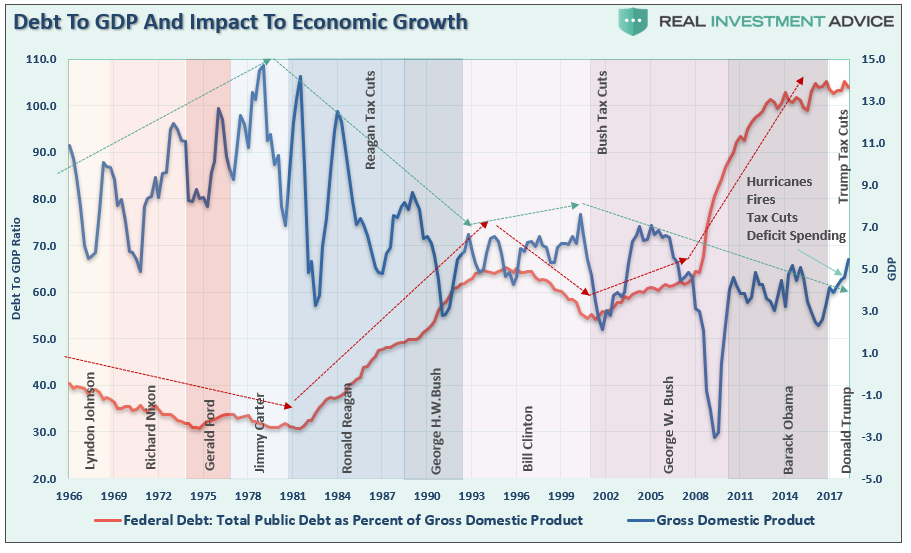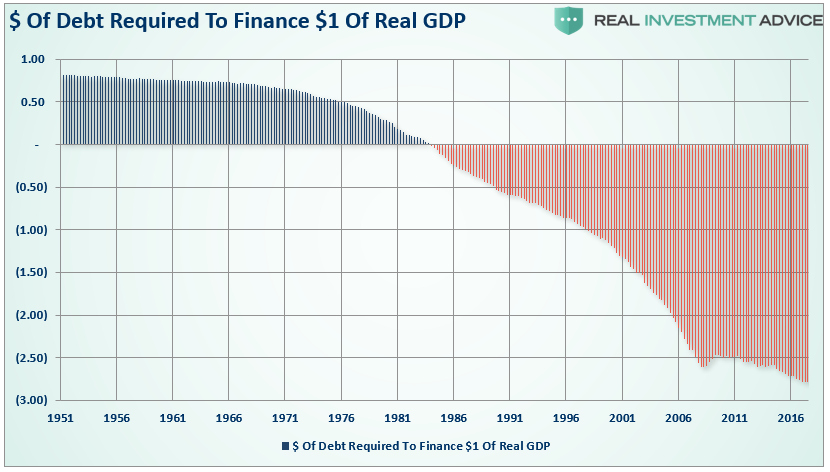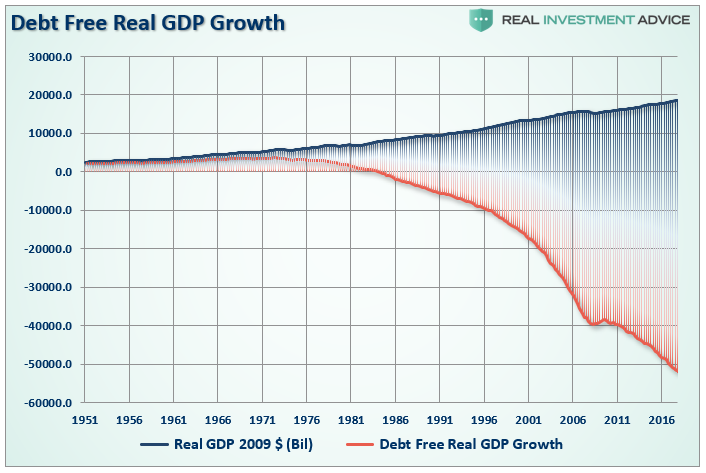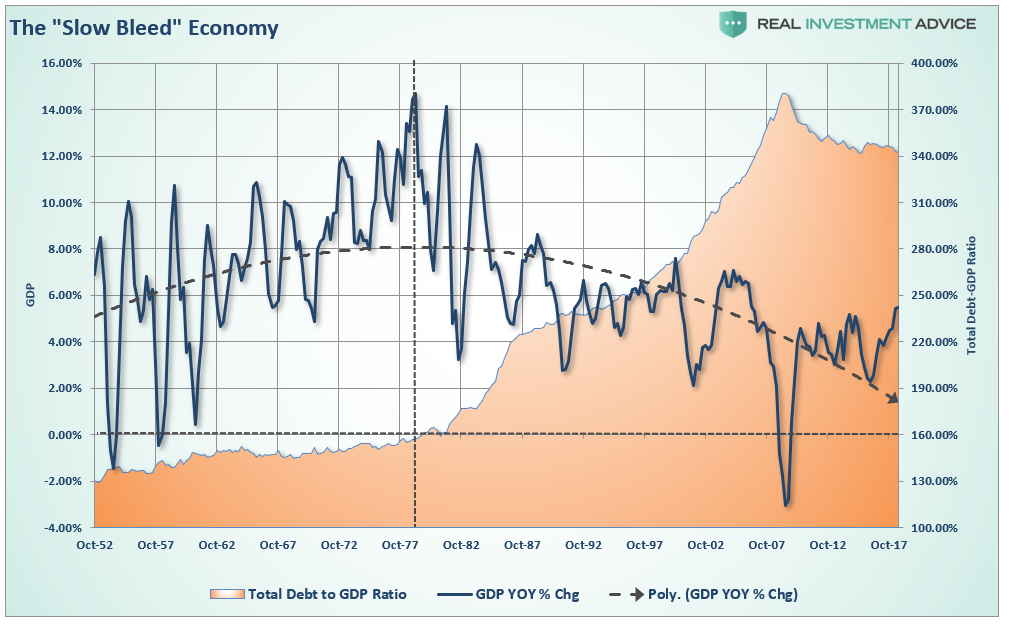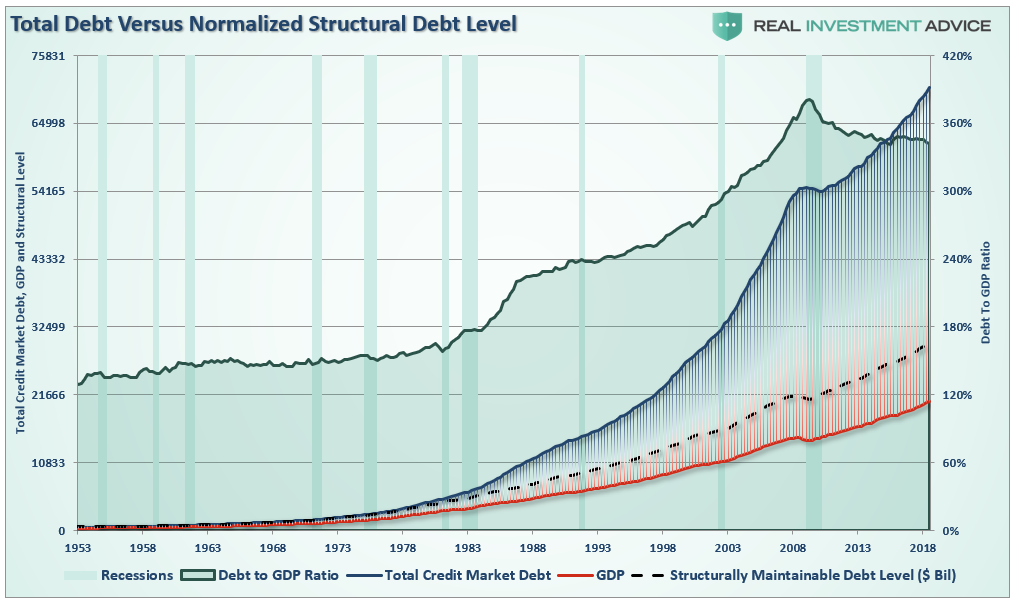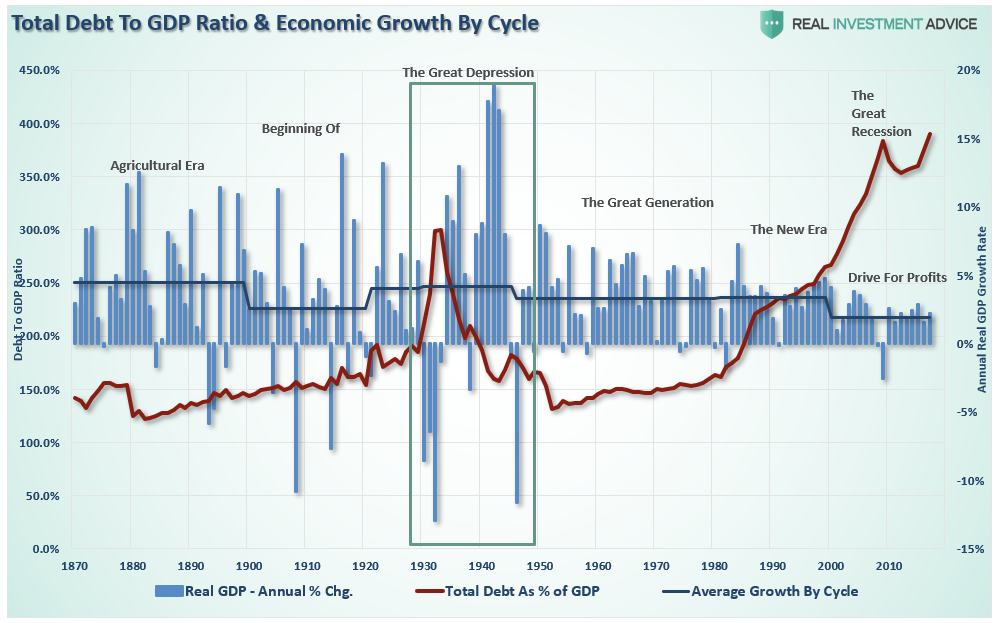“The Economic Consequences Of Debt”
Dieser Blog hat ein Kernthema: die Folgen einer Politik, die auf zunehmende Verschuldung setzt, um über Stagnation und Niedergang hinwegzutäuschen. Deshalb freut es mich immer wieder, wenn es Beiträge gibt, die knapp die Wirkungen der süßen Droge Schulden zusammenfassen. So dieser Beitrag von Real Investment Advice:
- “Debt, if used for productive investments, can be a solution to stimulating economic growth in the short-term. This past couple of quarters was a good example of this as the spending on defense and rebuilding from 3-major hurricanes last year pushed economic activity up in 2018.” – bto: wobei ich hier schon Bauchschmerzen habe. Der Ersatz von zerstörten Wirtschaftsgütern und Ausgaben für Militär sind Konsum und erhöhen nicht die Schuldentragfähigkeit eines Landes (außer man nutzt die Waffen, um andere zu überfallen und sich dort Schuldendeckungsmittel zu beschaffen).
- “However, these ‘sugar highs’ are temporary in nature. The problem is the massive surge in unbridled deficit spending which provides the temporary illusion of economic growth simply ‘pulls forward’ future consumption leaving a void that must be filled.” – bto: Das wiederum stimmt.
- “Since the bulk of the debt issued by the U.S. has been squandered on increases in social welfare programs and debt service, there is a negative return on investment. Therefore, the larger the balance of debt becomes, the more economically destructive it is by diverting an ever growing amount of dollars away from productive investments to service payments.” – bto: Es ist Konsum, nichts anderes. Das kann niemals bezahlt werden.
- “The relevance of debt growth versus economic growth is all too evident as shown below. Since 1980, the overall increase in debt has surged to levels that currently usurp the entirety of economic growth. With economic growth rates now at the lowest levels on record, the growth in debt continues to divert more tax dollars away from productive investments into the service of debt and social welfare.” – bto: Und das ist nicht nur in den USA so, sondern weltweit ein Problem.
Quelle: REAL INVESTMENT ADVICE
- “It now requires nearly $3.00 of debt to create $1 of economic growth.” – bto: eine Relation, die sich immer mehr verschlechtert, weil Schulden eben immer weniger in der Realwirtschaft ankommen.
Quelle: REAL INVESTMENT ADVICE
- “Another way to view the impact of debt on the economy is to look at what “debt-free” economic growth would be. In other words, without debt, there has actually been no organic economic growth.” – bto: Das ist natürlich eine theoretische Betrachtung. Dennoch nicht zu unterschätzen.
Quelle: REAL INVESTMENT ADVICE
- “But it isn’t just Federal debt that is the problem. It is all debt. When it comes to households, which are responsible for roughly 2/3rds of economic growth through personal consumption expenditures, debt was used to sustain a standard of living well beyond what income and wage growth could support. This worked out as long as the ability to leverage indebtedness was an option. The problem is that when rising interest rates hit a point where additional leverage becomes problematic, further economic cannot be achieved. Given the massive increase in deficit spending by households to support consumption, the ‘bang point’ between rates and the economy is likely closer than most believe.” – bto: was auch die abnehmende Wirkung der Zusatzverschuldung erklärt.
Quelle: REAL INVESTMENT ADVICE
- Und dann kommt es zu entscheidenden Ursachenfrage: “What was the difference between pre-1980 and post-1980? From 1950-1980, the economy grew at an annualized rate of 7.70%. This was accomplished with a total credit market debt to GDP ratio of less 160%. (…) The obvious problem is the ongoing decline in economic growth over the past 35 years has kept the average American struggling to maintain their standard of living. As real wage growth remains primarily stagnate, consumers are forced to turn to credit to fill the gap in maintaining their current standard of living. However, as more leverage is taken on, the more dollars are diverted from consumption to debt service thereby weighing on stronger rates of economic growth.” – bto: So ist es. Dann ist es aber nur vorgezogener Konsum! Der später fehlt.
Quelle: REAL INVESTMENT ADVICE
- “The massive indulgence in debt has simply created a ‘credit-induced boom’ which has now reached its inevitable conclusion. While the Federal Reserve believed that creating a ‘wealth effect’ by suppressing interest rates to allow cheaper debt creation would repair the economic ills of the ‘Great Recession,’ it only succeeded in creating an even bigger ‘debt bubble’ a decade later.” – bto: So einfach ist es.
- “This unsustainable credit-sourced boom led to artificially stimulated borrowing which pushed money into diminishing investment opportunities and widespread mal-investments. In 2007, we clearly saw it play out ‘real-time’ in everything from sub-prime mortgages to derivative instruments which were only for the purpose of milking the system of every potential penny regardless of the apparent underlying risk. Today, we see it again in accelerated stock buybacks, low-quality debt issuance, debt-funded dividends, and speculative investments.” – bto: mit allen damit verbundenen Nebenwirkungen!
- “When credit creation can no longer be sustained, the markets must clear the excesses before the next cycle can begin. It is only then, and must be allowed to happen, can resources be reallocated back towards more efficient uses. This is why all the efforts of Keynesian policies to stimulate growth in the economy have ultimately failed. Those fiscal and monetary policies, from TARP and QE, to tax cuts, only delay the clearing process. Ultimately, that delay only deepens the process when it begins.” – bto: Diese Bereinigung wäre so brutal, dass sie die große Depression in den Schatten stellen würde. Deshalb wird sie noch lange nicht kommen, sondern durch immer radikalere Interventionen aufgeschoben.
- “The biggest risk in the coming recession is the potential depth of that clearing process. With the economy currently requiring roughly $3 of debt to create $1 of economic growth. A reversion to a structurally manageable level of debt would involve a nearly $40 Trillion reduction of total credit market debt from current levels.” – bto: Wenn das keine massive deflationäre Depression ist, dann weiß ich es nicht.
Quelle: REAL INVESTMENT ADVICE
- “The economic drag from such a reduction would be a devastating process which is why Central Banks worldwide are terrified of such a reversion. In fact, the last time such a reversion occurred the period was known as the ‘Great Depression’.” – bto: So ist es. Politisch ein Alptraum. Übrigens auch für uns, obwohl wir nicht so viele Schulden haben. Wir sind Gläubiger und werden besonders schlecht regiert.
Quelle: REAL INVESTMENT ADVICE
“(…) one thing we know for sure is that ‘debt matters.’” – bto: und wie!
→ realinvestmentadvice.com: “The Economic Consequences Of Debt”, 12. November 2018





